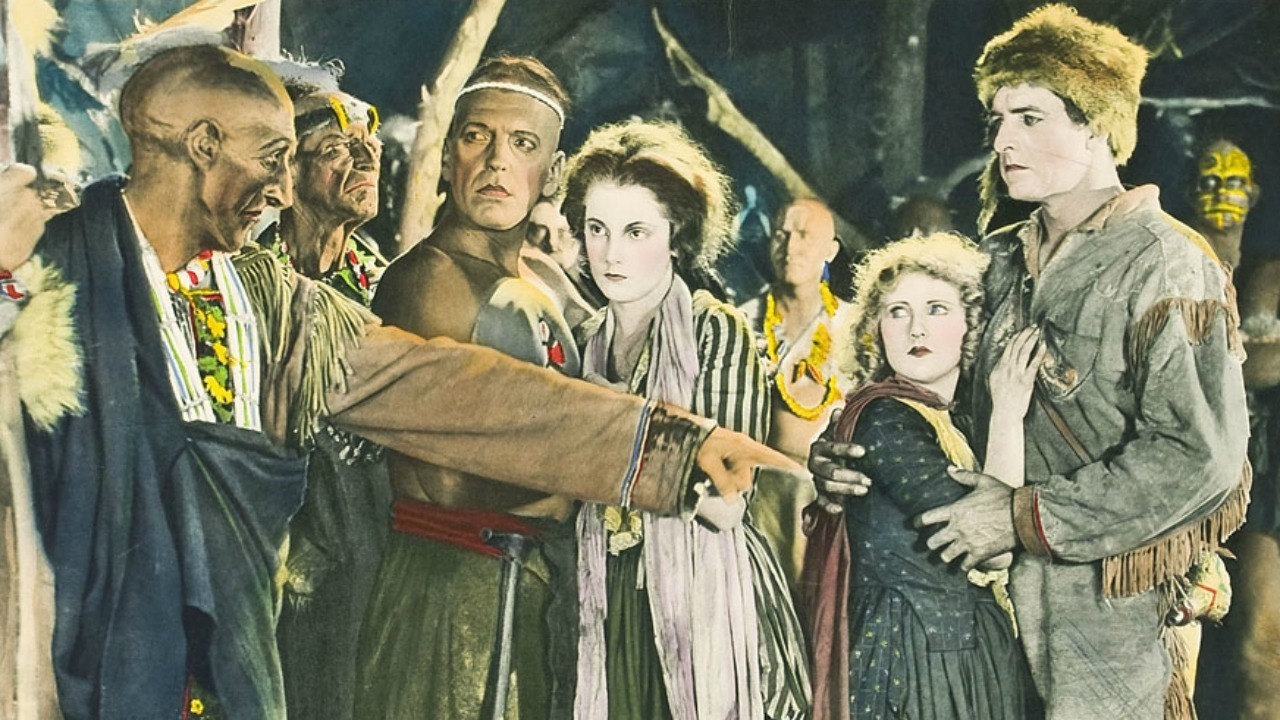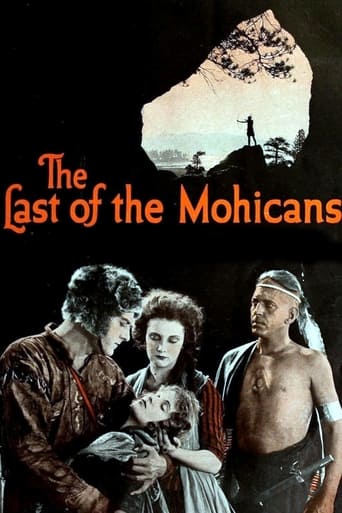

This movie is the proof that the world is becoming a sick and dumb place
... View Morea film so unique, intoxicating and bizarre that it not only demands another viewing, but is also forgivable as a satirical comedy where the jokes eventually take the back seat.
... View MoreIt’s sentimental, ridiculously long and only occasionally funny
... View MoreThis is a small, humorous movie in some ways, but it has a huge heart. What a nice experience.
... View MoreLast of the Mohicans, The (1920) *** (out of 4) Early adaptation of James Fenimore Cooper's novel doesn't have the best of stories and has more in common with The Birth of a Nation rather than the book but overall the film remained entertaining. The best moments happen at the end with a dazzling action sequence on a tall cliff that has to be seen to believed. Follow that up with a terrific knife fight with some beautiful locations makes this an easy film to recommend. But be forewarned that if you were offended by the Griffith film then you'll probably be even more outraged here. The cliff scene borrows a lot from the Griffith movie and some of the battle scenes do as well but with the white actors playing Indians with paint on them (which you can see melting in a few scenes) and some of the negative stereotypes some might find it offensive. Boris Karloff was an extra in this film but I wasn't able to spot him while watching.
... View MoreHaving only seen the 1990s version of this story and not having read the book, I can't say how true this film is to Cooper's vision so you'd have to look to other posters for that. I will say that it feels much more dark and brooding than the later version. Maurice Tourneur's visuals are wonderful, taking in the vistas of the West and framing the drama of the characters on an appropriately vast scale.Here we have the story of 2 sisters, dark haired and resolute Cora (Barbara Bedford) and fair haired and similarly gentle in demeanor Alice (Lillian Hall), who are caught up in the violence of the French and Indian War because their father (James Gordon) commands a fort on the frontier. Cora finds her protector in a Native Mohican hunter named Uncas (Alan Roscoe) who manages to rescue her from the clutches of the conniving Magua (Wallace Beery). There is treachery on the part of both the English and the Indians, and the film takes pains to show that the Indians are not inherently evil but mislead by greedy white men and the unscrupulous Magua.The performances in this film, with the exception of Wallace Beery, are for the most part very restrained and emotive as opposed to some of the more expressive styles of silent acting that you saw a lot in the late teens. Beery is way over the top but that's presumably the way the directors wanted him to be. There's one shot where he completely goes ape-wild and jumps at the camera with his mouth and eyes wide open, the total "savage" image designed apparently to startle audiences who'd rather keep a character like Magua at arm's length. Bedford's face is really remarkable, so much expression and fragility. Roscoe is somewhat less well cast, not simply because of the racial issues but just because he looks a bit too old to be the romantic he's being described as here. His acting is good though, and the two have decent chemistry.I watched the movie mostly to study Maurice Tourneur's technique. I hadn't realized he co-directed it with Clarence Brown, his protégé, until I saw his name on the credits. I can't really assess what kind of role Brown played because the film doesn't show any kind of divisions and most of the visual style that I picked up on were things that I recognized from previous Tourneur films. Tourneur and Brown always worked together in those years officially or unofficially though is my understanding. Twice in the film we see what is the most distinctive type of shot that Tourneur uses at least in his silent American films, a dark silhouette framed by a triangular shaped cave opening behind which sprawls an epic landscape. The same type of shot was used to great effect in his version of "Treasure Island" and has been imitated or payed homage to in dozens of films. You can see variations of it in many of his films; for example in "Victory" he has this really striking shot of a fisherman on the shore, with his body and his rod pushed to the extreme edge of the frame and a large sea ship passing in the distance framed against a dark triangular rock. Also as in "Victory" of the previous year 1919, in "Mohicans" the most brutal violence is handled in a foreground silhouette, which produces a stylized effect very similar to what you would see in a modern graphic novel. Generally speaking, Tourneur was a master at shooting perspective in the outdoors, and the photography that Philip Du Bois and Charles Van Enger did in what looks like Yosemite Valley is some of the most impressive that you will see in any film.I can't hugely recommend the movie because it's so tragic and I'm just not crazy about that type of story, although I think it was done in a less melodramatic and more impressionistic way than in the other version I've seen. It's a relief not to be forced to sit through the "dialog" of these two lovers; in this particular story I think it's a lot stronger for the feelings to be left unsaid.
... View MoreThis is considered one of the great silent films of all time. Hmmm Yes, some of the photography is strong and NICELY restored, and a few scenes must've been absolutely gripping for the 1920 audience, but folks, this is NO "The Passion of Joan of Arc" (silent, 1928). The acting in "Mohicans" is SO melodramatic you MUST laugh at it! many of the stereotypes are classically dopey the continuity and visual logic often fall to pieces the dialog is SO out of character for most of the speakers it's almost surreal (Did that Indian just quote Shakespeare?) etc. It's no "greatest" film, but it has its moments, definitely. For someone interested in film, this should be on the list. For anyone else I sort of doubt it.
... View MoreThis film is well photographed, as are most of the films I've seen that are directed by Maurice Tourneur. The framing and composition of shots are apt, except occasionally when it is theatrical. Much of the action happens outside, which helps--freeing the camera and providing scenery. There are some nice lighting effects: use of low-key lighting, nighttime photography, the flickering light against a wall to represent candlelight and such. There are some silhouette shots, which seem to be a trademark in Tourneur's films. The tinting, too, adds to the film's beauty.Some moments show a resemblance to D.W. Griffith and Billy Bitzer's work, such as "The Battle at Elderbush Gulch" and "The Birth of a Nation". There are the iris shots and actor's approaching the camera, both of which were likely invented by Griffith and Bitzer. The battle scene at the fort is rather Griffith-like. Impressively innovative is the pan of the faces of Magua and Uncas and then them rushing towards the camera, as they begin fighting. The main pictorial schema for this film, and I think it's a good one, if not entirely original, is switching from distanced views to intimate shots, thus taking in the breadth of the scenic environment and concentrating on the story's action. This can be seen in the battle scenes, the cliff scene and pretty much every other important scene outside.I've referred to this as Tourneur's film, but that's doubtful. Clarence Brown, Tourneur's longtime assistant, directed most of the shooting, due to Tourneur being ill. In the early days without detailed shooting scripts, it's questionable as to how much of the film was the conception and design of Tourneur, but Brown having worked under him, the issue is probably moot. Perhaps, the poor use of the same set for fictionally different locations, made obvious by the successive cuts, in addition to other minor amateurish mistakes, can be blamed on inexperience.Of worse error are Caucasians playing Indians and the film's occasional condescension and racism, although the film can be commended for its generally respectful treatment. As well, intertitles do replace some action and acting in this film, as fellow commenter Sorsimus criticized. And, the story contrives three moments where dark hair faces the choice of replacing herself for yellow hair as Magua's captive. The film appears rather unpolished at times, as a result. These are rather minor, or commonplace, problems, though.This is a promising early film for Brown, at the peak of Tourneur's career. Tourneur, a pioneer of the medium, dealt with a variety of stories, so from there one can't characterize his body of work easily; it's in cinematography that a characteristic style of innovation and the use of the best of film grammar known can be seen. For Brown, his films would surpass the visual brilliance of his master, with films such as, say, "The Flesh and the Devil". Here, it seems he wisely worked from the style of Tourneur to create some very interesting photography.
... View More